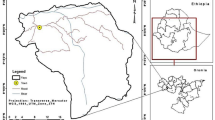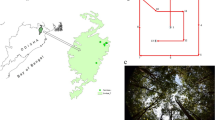Abstract
Forests are one of the most significant and major carbon sinks. Understanding the global carbon cycle requires assessing the quantity of carbon stored in forests. Remote sensing has been widely employed for estimating forest biomass from local to global. Several forest factors have been mapped or simulated using remote sensing data alone or in conjunction with field data, making forest mapping a broad field. The use of hyperspectral sensors has dominated the past ten years. The potential of the spaceborne hyperspectral sensor PRISMA is the main focus of this study. The goal of this study is to provide the most up-to-date information on hyperspectral remote sensing from space by focusing on estimating aboveground biomass (AGB) and the feasibility of PRISMA in the challenging phenological circumstances of a tropical dry deciduous forest. The objective of the study was to estimate AGB using PRISMA data and to check the phenological variations of AGB. Findings showed that the employed vegetation indices (c) and phenological conditions significantly impacted the predicted accuracy. Results conclude that the atmospherically resistant vegetation index outperforms the enhanced vegetation index (EVI), normalized difference vegetation index, and simple ratio index for PRISMA, with MAE = 5.42 t/ha, RMSE = 6.43 t/ha, and R2 = 0.34. It is also predicted that adverse phenological circumstances were the cause of the poor correlation between field biomass and predicted biomass. To check the phenological variation, AGB was also assessed by Landsat 8 data using the same vegetation indices, in which EVI performed better than others with a 0.72 R2 value. The study indicated that phenological variations have a significant impact on AGB estimation, and narrowband indices can be useful in such studies.






Similar content being viewed by others
References
Astor, T., Dayananda, S., Nautiyal, S., & Wachendorf, M. (2020). Vegetable crop biomass estimation using hyperspectral and RGB 3D UAV data. Agronomy, 10(10), 1600.
Baccini, A., Goetz, S. J., Walker, W. S., Laporte, N. T., Sun, M., Sulla-Menashe, D., Hackler, J., Beck, P. S. A., Dubayah, R., Friedl, M. A., Samanta, S., & Houghton, R. A. (2012). Estimated carbon dioxide emissions from tropical deforestation improved by carbon-density maps. Nature Climate Change, 2(3), 182–185. https://doi.org/10.1038/nclimate1354
Berger, K., Hank, T., Halabuk, A., Rivera-Caicedo, J. P., Wocher, M., Mojses, M., Gerhátová, K., Tagliabue, G., Dolz, M. M., Venteo, A. B. P., & Verrelst, J. (2021). Assessing non-photosynthetic cropland biomass from spaceborne hyperspectral imagery. Remote Sensing, 13(22), 4711. https://doi.org/10.3390/rs13224711
Brovkina, O., Novotny, J., Cienciala, E., Zemek, F., & Russ, R. (2017). Mapping forest aboveground biomass using airborne hyperspectral and LiDAR data in the mountainous conditions of Central Europe. Ecological Engineering, 100, 219–230. https://doi.org/10.1016/j.ecoleng.2016.12.004
Champion, H. G., & Seth, S. K. (1968). A revised survey of the forest types of India. Manager of publications.
Christian, B., Joshi, N., Saini, M., Mehta, N., Goroshi, S., Nidamanuri, R. R., Thenkabail, P., Desai, A. R., & Krishnayya, N. S. R. (2015). Seasonal variations in phenology and productivity of a tropical dry deciduous forest from MODIS and Hyperion. Agricultural and Forest Meteorology, 214–215, 91–105. https://doi.org/10.1016/j.agrformet.2015.08.246
Christian, B., & Krishnayya, N. S. R. (2009). Classification of tropical trees growing in a sanctuary using Hyperion (EO-1) and SAM algorithm. Current Science., 96(12), 1601–1607.
Dayananda, S., Astor, T., Wijesingha, J., ChickadibburahalliThimappa, S., DimbaChowdappa, H., Mudalagiriyappa, N. R. R., Nautiyal, S., & Wachendorf, M. (2019). Multi-temporal monsoon crop biomass estimation using hyperspectral imaging. Remote Sensing, 11(15), 1771.
de Almeida, C. T., Galvao, L. S., Ometto, J. P., Jacon, A. D., de Souza Pereira, F. R., Sato, L. Y., Lopes, A. P., de AlencastroGraça, P. M., de Jesus Silva, C. V., Ferreira-Ferreira, J., & Longo, M. (2019). Combining LiDAR and hyperspectral data for aboveground biomass modeling in the Brazilian Amazon using different regression algorithms. Remote Sensing of Environment, 232, 111323. https://doi.org/10.1016/j.rse.2019.111323
Volume Equations for Forests of India Nepal and Bhutan, Forest Survey of India. (1996).
Galvão, L. S., Almeida de Souza, A., & Breunig, F. M. (2020). A hyperspectral experiment over tropical forests based on the EO-1 orbit change and PROSAIL simulation. Giscience and Remote Sensing, 57(1), 74–90. https://doi.org/10.1080/15481603.2019.1668595
Gao, L., Chai, G., & Zhang, X. (2022). Above-ground biomass estimation of plantation with different tree species using airborne LiDAR and hyperspectral data. Remote Sensing, 14(11), 2568. https://doi.org/10.3390/rs14112568
Gonzalez de Tanago, J., Lau, A., Bartholomeus, H., Herold, M., Avitabile, V., Raumonen, P., Martius, C., Goodman, R. C., Disney, M., Manuri, S., Burt, A., & Calders, K. (2018). Estimation of above-ground biomass of large tropical trees with terrestrial LiDAR. Methods in Ecology and Evolution, 9(2), 223–234. https://doi.org/10.1111/2041-210X.12904
Gupta, R., & Sharma, L. K. (2020). Efficacy of spatial land change Modeler as a forecasting indicator for anthropogenic change dynamics over five decades: A case study of Shoolpaneshwar Wildlife Sanctuary, Gujarat, India. Ecological Indicators, 112, 10671. https://doi.org/10.1016/j.ecolind.2020.106171
Hati, J. P., Chaube, N. R., Hazra, S., Goswami, S., Pramanick, N., Samanta, S., & Mukhopadhyay, A. (2022). Mangrove monitoring in Lothian Island using airborne hyperspectral AVIRIS-NG data. Advances in Space Research.
Indirabai, I., Nair, M. V., Nair, J. R., & Nidamanuri, R. R. (2019). Estimation of biomass and leaf area index in the western ghats forest ecosystem by the integrated analysis of hyperspectral data and space borne LiDAR data. Journal of Geography, Environment and Earth Science International, 19(4), 1–12.
Jacon, A. D., Galvão, L. S., Dalagnol, R., & dos Santos, J. R. (2021). Aboveground biomass estimates over Brazilian savannas using hyperspectral metrics and machine learning models: Experiences with Hyperion/EO-1. Giscience and Remote Sensing, 58(7), 1112–1129. https://doi.org/10.1080/15481603.2021.1969630
Kumar, S., & Ramana, M. G. (2017). Management plan for Shoolpaneshwar wildlife sanctuary. Narmada Forest Division, Gujarat Forest Department, Gujarat, India.
Kumar, L., & Mutanga, O. (2017). Remote sensing of above-ground biomass. Remote Sensing, 9(9), 935. https://doi.org/10.3390/rs9090935
Laurin, G. V., Chen, Q., Lindsell, J. A., Coomes, D. A., Del Frate, F., Guerriero, L., & Valentini, R. (2014). Above ground biomass estimation in an African tropical forest with lidar and hyperspectral data. ISPRS Journal of Photogrammetry and Remote Sensing, 89, 49–58. https://doi.org/10.1016/j.isprsjprs.2014.01.001
Laurin, G. V., Puletti, N., Grotti, M., Stereńczak, K., Modzelewska, A., Lisiewicz, M., & Papale, D. (2020). Species dominance and above ground biomass in the Białowieża Forest, Poland, described by airborne hyperspectral and lidar data. International Journal of Applied Earth Observation and Geoinformation, 92, 102178.
Loredana, P., Mirco, B., Matteo, P., Michele, P., Ranghetti, L., & Monica, P. (2021). Mapping cellulose absorption band in NPV using prisma data. In: International Geoscience and Remote Sensing Symposium (IGARSS), (pp. 475–478). https://doi.org/10.1109/IGARSS47720.2021.9554048
Malhi, R. K. M., Anand, A., Mudaliar, A. N., Pandey, P. C., Srivastava, P. K., & Sandhya Kiran, G. (2020). Synergetic use of in situ and hyperspectral data for mapping species diversity and above ground biomass in Shoolpaneshwar Wildlife Sanctuary Gujarat. Tropical Ecology, 61(1), 106–115. https://doi.org/10.1007/s42965-020-00068-8
Marshall, M., Belgiu, M., Boschetti, M., Pepe, M., Stein, A., & Nelson, A. (2022). Field-level crop yield estimation with PRISMA and Sentinel-2. ISPRS Journal of Photogrammetry and Remote Sensing, 187, 191–210. https://doi.org/10.1016/j.isprsjprs.2022.03.008
Nandy, S., Ghosh, S., Kushwaha, S. P. S., & Senthil Kumar, A. (2019). Remote sensing-based forest biomass assessment in northwest Himalayan landscape. In R. R. Navalgund, A. Senthil Kumar, & S. Nandy (Eds.), Remote sensing of northwest Himalayan ecosystems (pp. 285–311). Springer Singapore. https://doi.org/10.1007/978-981-13-2128-3_13
Nandy, S., & Kushwaha, S. P. (2021). Forest biomass assessment integrating field inventory and optical remote sensing data: A systematic review. International Journal of Plant and Environment, 7(03), 181–186.
Nandy, S., Singh, R., Ghosh, S., Watham, T., Kushwaha, S. P. S., Kumar, A. S., & Dadhwal, V. K. (2017). Neural network-based modelling for forest biomass assessment. Carbon Management, 8(4), 305–317.
Nandy, S., Srinet, R., & Padalia, H. (2021). Mapping forest height and aboveground biomass by integrating ICESat‐2, Sentinel‐1 and Sentinel‐2 data using Random Forest algorithm in northwest Himalayan foothills of India. Geophysical Research Letters, 48(14), e2021GL093799. https://doi.org/10.1029/2021GL093799
Navarro, A., Young, M., Allan, B., Carnell, P., Macreadie, P., & Ierodiaconou, D. (2020). The application of Unmanned Aerial Vehicles (UAVs) to estimate above-ground biomass of mangrove ecosystems. Remote Sensing of Environment, 242, 111747. https://doi.org/10.1016/j.rse.2020.111747
Niu, Y., Zhang, L., Zhang, H., Han, W., & Peng, X. (2019). Estimating above-ground biomass of maize using features derived from UAV-based RGB imagery. Remote Sensing, 11(11), 1261. https://doi.org/10.3390/rs11111261
Nuthammachot, N., Askar, A., Stratoulias, D., & Wicaksono, P. (2022). Combined use of Sentinel-1 and Sentinel-2 data for improving above-ground biomass estimation. Geocarto International, 37(2), 366–376. https://doi.org/10.1080/10106049.2020.1726507
O’Shea, R. E., Pahlevan, N., Smith, B., Bresciani, M., Egerton, T., Giardino, C., Li, L., Moore, T., Ruiz-Verdu, A., Ruberg, S., Simis, S. G. H., Stumpf, R., & Vaičiūtė, D. (2021). Advancing cyanobacteria biomass estimation from hyperspectral observations: Demonstrations with HICO and PRISMA imagery. Remote Sensing of Environment, 266, 112693. https://doi.org/10.1016/j.rse.2021.112693
Pandey, P. C., Anand, A., & Srivastava, P. K. (2019). Spatial distribution of mangrove forest species and biomass assessment using field inventory and earth observation hyperspectral data. Biodiversity and Conservation, 28, 2143–2162.
Toniol, A. C., Galvão, L. S., Ponzoni, F. J., Sano, E. E., & de Jesus Amore, D. (2017). Potential of hyperspectral metrics and classifiers for mapping Brazilian savannas in the rainy and dry seasons. Remote Sensing Applications: Society and Environment, 8, 20–29. https://doi.org/10.1016/j.rsase.2017.07.004
Vashum, K. T. (2012). Methods to estimate above-ground biomass and carbon stock in natural forests—A review. Journal of Ecosystem & Ecography, 02(04), 1–7. https://doi.org/10.4172/2157-7625.1000116
Verma, R. K., Sharma, L. K., & Lele, N. (2023). AVIRIS-NG hyperspectral data for biomass modeling: From ground plot selection to forest species recognition. Journal of Applied Remote Sensing, 17(01), 014522. https://doi.org/10.1117/1.JRS.17.014522
Xu, D., Wang, C., Chen, J., Shen, M., Shen, B., Yan, R., Li, Z., Karnieli, A., Chen, J., Yan, Y., Wang, X., Chen, B., Yin, D., & Xin, X. (2021). The superiority of the normalized difference phenology index (NDPI) for estimating grassland aboveground fresh biomass. Remote Sensing of Environment, 264, 112578. https://doi.org/10.1016/j.rse.2021.112578
Yang, S., Feng, Q., Liang, T., Liu, B., Zhang, W., & Xie, H. (2018). Modeling grassland above-ground biomass based on artificial neural network and remote sensing in the Three-River Headwaters Region. Remote Sensing of Environment, 204, 448–455. https://doi.org/10.1016/j.rse.2017.10.011
Zaki, N. A. M., Abd Latif, Z., & Zainal, M. Z. (2016). Aboveground biomass and carbon stock estimation using double sampling approach and remotely-sensed data. Jurnal Teknologi, 78(5–4), 57–62. https://doi.org/10.11113/jt.v78.8551
Zhang, X., Chen, X., Tian, M., Fan, Y., Ma, J., & Xing, D. (2020). An evaluation model for aboveground biomass based on hyperspectral data from field and TM8 in Khorchin grassland, China. PLoS ONE, 15(2), e0223934. https://doi.org/10.1371/journal.pone.0223934
Acknowledgements
We are grateful to the Central University of Rajasthan for providing research facilities through the Department of Science & technology (DST-FIST) funded Remote Sensing and GIS Lab in the Department of Environmental Science. Additionally, we are grateful to the Narmada Forest Division's assistance in field visits and the teams behind USGS Earth Explorer (https://earthexplorer.usgs.gov/) and Prisma (http://.prisma.asi.it/).
Funding
The authors declared that no funding was received for this research.
Author information
Authors and Affiliations
Contributions
RKV and LKS are conducted, data collection, design, and conceptualization of the research. IK and MKR are involved in data interpretation and writing. LKS is involved in guiding and result interpretation. RKV wrote the original manuscript.
Corresponding author
Ethics declarations
Conflict of interest
The authors declared that they have no conflict of interest.
Additional information
Publisher's Note
Springer Nature remains neutral with regard to jurisdictional claims in published maps and institutional affiliations.
About this article
Cite this article
Verma, R.K., Sharma, L.K., Bhaveshkumar, K. et al. Assessment of Aboveground Biomass in a Tropical Dry Deciduous Forest Using PRISMA Data. J Indian Soc Remote Sens (2024). https://doi.org/10.1007/s12524-024-01822-4
Received:
Accepted:
Published:
DOI: https://doi.org/10.1007/s12524-024-01822-4




